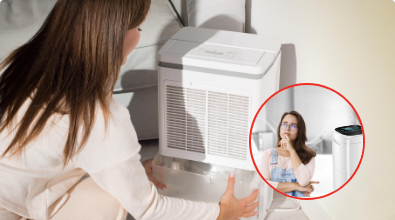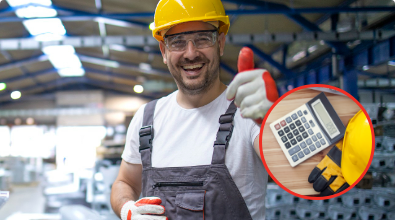How to do home dehumidifier sizing?
Residential establishments are often prone to high levels of moisture, specifically during the humid seasons, or during sudden climatic variations. Sudden fluctuations in the humidity levels can lead to high discomfort and create hazards for the health of occupants.
These risks are in the form of difficulty breathing, respiratory issues, bacterial growth such as mold and mildew, musty odors, structural disfigurement, and much more.
Home dehumidifier sizing plays a pivotal role in ensuring effective humidity removal and moisture management, as different residential properties impose different humidity scenarios, depending upon the total area of the settlement.
Under such circumstances, choosing a home dehumidification unit with a moisture removal capacity that resonates with your specific requirements is extremely crucial.
An undersized unit may not be able to remove the over-abundant humidity levels from your vicinity efficiently. On the contrary, an oversized unit might lead to excess energy consumption and unnecessarily high utility bills.
In this blog, we are going to discuss step-by-step the process on how you can leverage our home dehumidifier size calculator and follow the steps to choose an air dryer that is ideal for your moisture management needs in your surroundings.
Additionally, we will guide you through the primary dehumidifier features, such as energy efficiency, noise levels, built-in pumps, and digital controls, to make you choose the right home dehumidifier capacity sizing for a comfortable and hassle-free living.
How to do a swimming pool dehumidifier calculation?
Recurring moisture generation in swimming pool settlements are a common issue, which if not addressed on time, can impose severe hazards to the occupants, as well as cause structural damage to the building, and also corrode expensive pool equipment and machinery.
The high levels of moisture in such arenas is primarily due to the large volumes of evaporation that takes place from the surface of pool waters, which gets catalyzed in the winters due to the usage of water heaters used to keep the pool waters warm.
Calculating the right size of a pool dehumidifier is essential to effectively control the humidity levels in a swimming pool area. A pool dehumidification system removes excess moisture from the air, preventing the issues mentioned above.
It helps create a comfortable environment for swimmers, protects the building from moisture-related damage, and reduces maintenance costs in the long run.
To perform a swimming pool dehumidifier calculation, several factors need to be considered. The detailed blog on "How to Do a Swimming Pool Dehumidifier Calculation" will guide you through the following steps:
Pool Size: Determining the size of the swimming pool is the first step. The blog will explain how to measure the length, width, and depth accurately.
Room Volume: The volume of the room housing the swimming pool also affects the pool dehumidifier sizing. The blog will describe how to calculate the room volume, taking into account the pool's size and the height of the ceiling.
Desired Relative Humidity: Defining the desired relative humidity level is important to ensure a comfortable and safe environment. The blog will provide guidance on choosing an appropriate relative humidity level for a swimming pool area.
Air Exchange Rate:The rate at which fresh air is exchanged with the pool area affects the dehumidifier calculation. The blog will explain how to determine the air exchange rate based on factors such as the number of occupants, ventilation system efficiency, and building codes.
Dehumidifier Capacity: Based on the pool size, room volume, desired relative humidity, and air exchange rate, the blog will outline how to use a pool dehumidifier formula for sizing to determine the appropriate capacity needed.
How does a dehumidifier work?
Dehumidification units are specifically designed, heavy-duty machinery that is used to remove excess moisture from the surroundings, and mitigate the risks associated with moisture-induced damage.
From industrial to commercial settings, residential to swimming pool properties, moisture management devices find extensive use in a wide array of applications.
They work on the base principle of drawing in moist air, passing it through a series of evaporator coils where the moisture is condensed to water droplets, followed by the re-heating of the dry air with the help of condenser coils, and then releasing it back to the surroundings.
This process follows until the desired humidity levels are achieved. Let us walk you through a brief step-by-step process into how a dehumidifier work does? which is explained in detail in our blog.
Moist air is drawn: The first step in the dehumidification process begins with the absorption of moist and humid air into the machine, drawn through the air inlet of the unit.
Humidity removal: The humid air is passed through a series of evaporator coils where the moisture is extracted and converted to water droplets.
Storage of condensate water: The condensate water is then stored in the built-in water tank, if any, or it is drained out via the hose pipe attachment.
Air reheating: The dry air is re-heated back with the help of condenser coils, and then released back into the vicinity through the air outlet. This process is repeated until the desired moisture levels are achieved.
How to select the best industrial dehumidifier?
Industrial and commercial establishments are known to carry out heavy-duty operations, and involve certain processes that make moisture generation a continuous process, which can be an alarming concern if not addressed on time.
Due to their large operational area, moisture levels are exceptionally high, and typically require advanced industrial dehumidification units, with a high moisture capacity, and equipped with advanced features and high-grade components that aid in achieving optimal operational efficiency with compromising or downgrading performance.
Several factors need to be taken into consideration when selecting the best industry dehumidifier that resonate with the preferences and demands of your establishment.
Some of the key factors are mobility, high dehumidifying capacity, efficient compressor, sturdy and durable construction, automatic operation, auto-defrost mechanism, water drainage system, and much more.
Surplus moisture in industrial factories can lead to the corrosion and degradation of expensive equipment and machinery, rendering them useless and incurring hefty losses.
Additionally, high moisture content might also interfere with the health of workers, in the form of respiratory and breathing issues, skin allergies, and more, which compels the need for dehumidification systems.
With an array of models available in multiple dimensions and capacities at CtrlTech, we offer humidity management solutions to cater to a diversified set of moisture surplus environments, for you to ensure a comfortable workspace with optimized humidity levels.
Overabundance of humidity can also lead to electrical malfunctions within the facility, lead to operational disruptions, degrade product shelf life, and result in frequent machine breakdowns, maintenance, and repairs in the long run.
To eradicate these hazards from happening, implementation of industrial dehumidification units is a crucial aspect, which cannot be turned a blind eye towards.
How to select the best swimming pool dehumidifier?
Swimming pool arenas are susceptible to continuous moisture generation as a part of the evaporation that takes place from the pool water surface.
In case of indoor swimming pools, the moisture levels drastically rises due to the area being enclosed and confined, backed by reduced airflow within the arena.
High humidity levels around swimming pools can be pretty dangerous, leading to slippery floors which can accelerate the risk of accidents.
Additionally, it can also deteriorate pool hygiene, corrode and damage pool pumps and motors, catalyze bacterial growth, lead to condensation on surfaces such as walls and ceilings, create chlorine imbalance, and more.
During the winters, this process surges up at an alarming rate due to the usage of internal water heaters to keep the pool watts warm.
Choosing the best swimming pool dehumidifier hence becomes crucial in these settlements to ensure a comfortable and smooth swimming experience for all occupants, and diminish the risks associated with excess humidity accumulation.
Choosing the right and ideal swimming pool dehumidifier depends upon an array of external factors, namely the frequency of usage of the pool, pool area, indoor temperature, number of occupants, etc.
Certain dynamics should also be taken into account such as if the interior aesthetics of the pool room are critical to maintain the overall decorum, a wall mounted unit will be more suitable as compared to a floor standing system.
If the pool area is large, a unit with a ductable design is usually preferred, for a more centralized and distributed airflow of dehumidified air across the entire space, for faster and effective humidity removal.
Other aspects are also considered, such as fresh air exchange, air filter to trap dirt particles and contaminants, energy efficiency, silent operation, etc.
Read our blog to know more about how you can make an informed decision on buying the best swimming pool dehumidifier.





